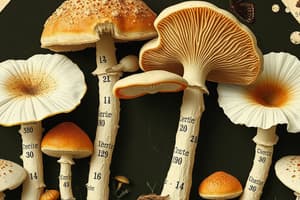Podcast
Questions and Answers
Which division is classified under the evolved fungi?
Which division is classified under the evolved fungi?
- Chytridiomycota
- Glomeromycota
- Zygomycota
- Ascomycota (correct)
What is the correct ending for the names of fungal classes?
What is the correct ending for the names of fungal classes?
- mycella
- mycophyta
- mycetes (correct)
- mycotina
Which of the following is NOT a subgroup of Mucoromycota?
Which of the following is NOT a subgroup of Mucoromycota?
- Mucoromycotina
- Mortierlomycotina
- Basidiomycota (correct)
- Glomeromycotina
Which of the following terms refer to the sub-divisions of the fungal kingdom?
Which of the following terms refer to the sub-divisions of the fungal kingdom?
Which sub-division is specifically stated to be remembered?
Which sub-division is specifically stated to be remembered?
What distinguishes eukaryotes from prokaryotes?
What distinguishes eukaryotes from prokaryotes?
Which characteristic is true about fungi?
Which characteristic is true about fungi?
What is a unique feature of the Opisthokonta supergroup?
What is a unique feature of the Opisthokonta supergroup?
How do fungi store their carbon reserves?
How do fungi store their carbon reserves?
What is the primary structural macromolecule used by fungi?
What is the primary structural macromolecule used by fungi?
What characteristics distinguish fungi from photosynthetic organisms?
What characteristics distinguish fungi from photosynthetic organisms?
Which process allows fungi to absorb nutrients from their environment?
Which process allows fungi to absorb nutrients from their environment?
Which of the following enzymes is NOT involved in the extracellular digestion of fungi?
Which of the following enzymes is NOT involved in the extracellular digestion of fungi?
What type of nutrients do fungi primarily absorb from their environment?
What type of nutrients do fungi primarily absorb from their environment?
Which of the following statements about fungi is true?
Which of the following statements about fungi is true?
What is the optimal pH range for mushroom growth?
What is the optimal pH range for mushroom growth?
Which two conditions are mushrooms particularly tolerant of?
Which two conditions are mushrooms particularly tolerant of?
What unique biosynthetic pathway do mushrooms utilize?
What unique biosynthetic pathway do mushrooms utilize?
What is the significance of vacuoles in mushrooms?
What is the significance of vacuoles in mushrooms?
What is the optimal temperature range for mushroom growth?
What is the optimal temperature range for mushroom growth?
Which compound is NOT able to pass through the fungal membrane?
Which compound is NOT able to pass through the fungal membrane?
What is the primary role of enzymes secreted by fungi?
What is the primary role of enzymes secreted by fungi?
Which characteristic is unique to the biosynthesis of lysine in fungi?
Which characteristic is unique to the biosynthesis of lysine in fungi?
Which element is NOT classified as a macro-element for fungi?
Which element is NOT classified as a macro-element for fungi?
What function do vacuoles serve in fungal cells?
What function do vacuoles serve in fungal cells?
Flashcards are hidden until you start studying
Study Notes
Types of Fungi
- Two main types exist: unicellular (yeasts) and filamentous fungi.
Classification of Fungi
- Fungi are positioned in the three domains of life: Eukaryotes, Archaea, and Bacteria.
- Prokaryotes lack a nucleus and organelles, whereas eukaryotes have a defined nucleus and organelles such as mitochondria and Golgi apparatus.
- Fungi are a monophyletic group within the Opisthokonta super-kingdom, indicating they share a common ancestor distinct from other groups.
Evolutionary Relationships
- Major branches in the eukaryotic evolutionary tree:
- Excavata: Often have a feeding groove.
- Amoebozoa: Recognized for amoeboid movement.
- Opisthokonta: Includes fungi, animals, and slime molds.
- SAR: Encompasses Stramenopiles, Alveolata, and Rhizaria.
- Archaeplastida: Contains plants and algal relatives.
- Unikonta: Defined by possessing a single flagellum.
Organization of Fungal Kingdom
- Organisms classified into divisions ending with "mycota":
- Chytridiomycota
- Mucoromycota (formerly Zygomycota) with three subdivisions:
- Glomeromycotina
- Mucoromycotina
- Mortierlomycotina
- Advanced divisions:
- Ascomycota
- Basidiomycota (part of the sub-kingdom "Dikarya")
General Characteristics of Fungi
- Eukaryotic organisms; can be unicellular (like yeasts) or multicellular (like filamentous fungi).
- Lack plastids and photosynthetic pigments, making them heterotrophic for carbon.
- Nutritional mode is osmotrophic, absorbing dissolved organic substances through cell membranes via extracellular digestion using hydrolytic enzymes.
- Small carbon molecules can be absorbed, while larger complexes require enzymatic breakdown.
Nutrition Requirements
- Macro-elements: Phosphate, sulfate, potassium, magnesium, calcium.
- Micro-elements: Zinc, manganese, iron, molybdenum.
- Growth factors: Essential vitamins.
- Water is vital for absorption of small organic carbon compounds and nitrogen sources.
Cellular Structure and Metabolism
- Fungal cell walls are rich in chitin.
- Glycogen is the primary storage polysaccharide.
- Unique lysine biosynthesis pathway via α-aminoadipate, seen only in fungi.
- Presence of vacuoles aids cellular homeostasis (maintaining water, ionic balance, and pH).
Fungal Tolerance and Growth
- Fungi demonstrate considerable tolerance to various environmental conditions:
- Acidic pH levels optimal at 5-6.
- Temperature tolerance ranges from 4°C to 37°C; optimal growth occurs around 18-22°C.
- Adaptation to low oxygen conditions, capable of surviving in environments with as little as 0.2% oxygen compared to the 20% found in air.
Studying That Suits You
Use AI to generate personalized quizzes and flashcards to suit your learning preferences.




